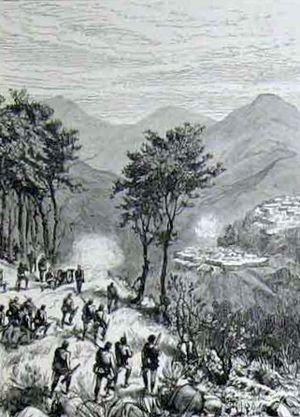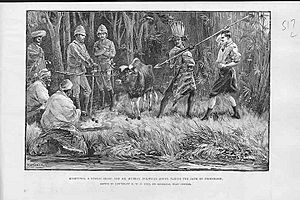Lushai Expedition facts for kids
The British Indian Army Lushai Expedition of 1871 to 1872 was a military trip. It was led by Generals Brownlow and Bourchier. The main goals of this trip were to rescue British people who had been captured by the Lushais. These captures happened during raids into Assam. One of the captives was a six-year-old girl named Mary Winchester. The expedition also aimed to show the local hill tribes that fighting the British Government would only cause them problems.
For the British, the expedition was a success. The captured people were set free. The hill tribes agreed to peace agreements. The border area then stayed peaceful until 1888. After that, large raids started again, and another military trip was planned.
Contents
Why the Expedition Happened
After a war in 1824, the British took control of Assam from the Burmese. For a while, the British tried to let a local prince, Purandar Singha, rule parts of Assam. But this plan didn't work. So, in 1838, Assam became fully controlled by the British.
On Assam's southern borders lived the Lushais. These were groups of tribes, sometimes called Kukies. For many years, even before the British arrived, people living in the plains were very afraid of the Kukies. The Kukies would attack villages, harming people, stealing things, and burning homes.
The first Kuki or Lushai attack in British-controlled Assam happened in 1826. From that year until 1850, British officers found it hard to stop these fierce attacks. Raids happened every year. Once, a British official reported that 150 people were killed in attacks by "Kookies."
Early Attempts to Stop Raids
In 1849, the Kuki attacks were so severe that Colonel Lister was sent to punish the tribes. He was the commander of the Sylhet Light Infantry. His trip in 1849–1850 was only partly successful. He found the land very difficult to travel through. He decided not to go further than the village of Mulla. This village was about 100 miles (160 km) across the border. Mulla had 800 houses. Colonel Lister surprised and destroyed the village without a fight, as all the men were away on a raid. His group also managed to free about 400 captives. Colonel Lister believed that these "robber tribes" would keep attacking unless they were dealt with very strictly. However, this trip did help keep the British Assam southern border mostly peaceful until 1862, when raids started again.
In 1868–1869, the Lushais burned a tea garden in Cachar and attacked Monierkhal. Another military trip was organized to follow the attackers, punish the tribes, and get back any captives. This trip was led by Colonel James Nuttall. It had three groups of soldiers. But the monsoon rains started, and they ran out of supplies. Because of this, the trip failed to achieve its main goals. No tribes were punished, and no captives were rescued.
The next year, Mr. Edgar, a British official, tried hard to make contact with the Lushais. He visited them across the border with a small group of guards. He tried to be friendly and make peace. However, his good intentions didn't work well. In 1870-1871, the Lushais carried out a series of raids that were bigger and more organized than before.
The Raids of 1870-1871
The first raid happened in the Chittagong Hill Tracts on December 31, 1870. On January 23, 1871, the village of Ainerkhal was burned. Twenty-five people were killed, and 37 were taken prisoner. On the same day, the tea garden at Alexandrapore was destroyed. Mr. Winchester, a tea planter, was killed. His six-year-old daughter, Mary, was carried away. Rescuing this kidnapped British girl became a very important reason for the expedition that followed.
A few hours after the attack on Winchester's tea garden, the nearby garden of Kutlicherra was attacked. But the Lushai raiders were driven away by two planters. The next day, a second attack was made on Kutlicherra, and two Lushais were wounded.
On January 26, the raiders surprised some British soldiers and police in the Monierkhal garden. They killed one soldier and wounded others. They then started to attack the fort and worker homes. When more British soldiers arrived, the Lushais retreated. They lost 57 men killed or wounded. The British lost six killed and six wounded.
The raiders became bolder. They went as far as Nundigram on January 27. They killed 11 people and took three away. The next morning, they attacked eight soldiers who were leaving Nundigram. These soldiers fought bravely, and only one escaped. The Lushais lost 25 men in this fight. On February 23, the Jhalnacherra tea garden was attacked. Seven workers were killed or wounded. Meanwhile, the Hill Tipperah and Chittagong Hill Tracts areas also suffered attacks, though not as badly.
The Expedition Begins
Because of these attacks, the British Government in India decided to send a large expedition into the Lushai country. This would happen during the cooler months. It was decided that the force would have two main groups. One group would start from Chittagong, and the other from Cachar. General Brownlow led the Chittagong group. General Bourchier led the Cachar group.
Besides these two main groups, a group of Meiteis (people from Manipur) also joined. They were led by Colonel James Nuttall. They helped by moving across the southern border to work with General Bourchier's group.
The military leaders were in charge of all parts of the expedition. They were told that the goal was not just to get revenge. They had to demand the release of all captured British people. They also had to try to make friends with the tribes. They needed to show them that being against the British Government would only lead to losses.
Cachar and Chittagong Columns
The Cachar group, which included artillery, engineers, and 500 riflemen, started on December 15, 1871. They faced a lot of resistance and traveled through very difficult land. General Bourchier destroyed the main village of the attacking tribes. He then set conditions for peace. Hostages were taken, and a fine of weapons and goods was collected. This group returned to Cachar on March 10, 1872.
The Chittagong group had about the same number of soldiers. They advanced from Demagiri to deal with the Lyloos and Howlongs tribes. These tribes were punished, and they fully surrendered under agreed terms. The conditions included returning all captives and promising to keep the peace in the future. At the end of the expedition, new forts were built along the border to protect it. Markets were also opened to encourage the Lushais to trade.
Aftermath
Assam then had a period of peace until 1888-1889. At that time, the hill people raided into Chittagong again. Assam sent 400 police officers to help. These police, along with a small group from the Chittagong force, attacked and destroyed several villages involved in the 1888 raids. When the troops left, they set up two posts in the North Lushai hills. One was at Aijal, and the other at Changsil. A British official was appointed to manage the North Lushai area, with his main office in Aijal. In 1891, another British group was attacked and killed. This led to the Chin-Lushai Expedition of 1889-90.



